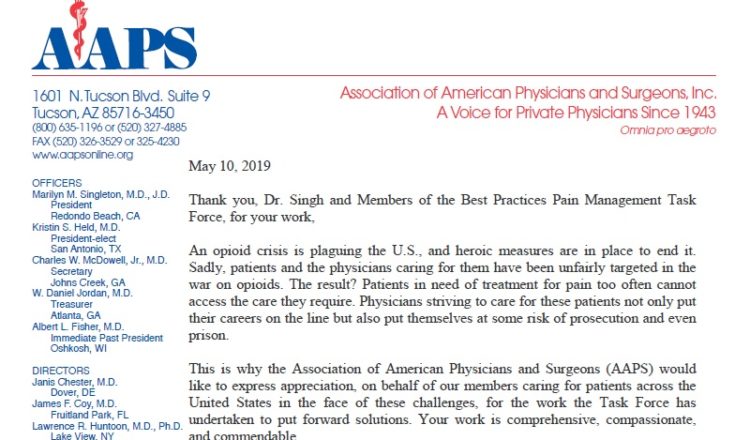To: Vanila M. Singh, MD, MACM Chief Medical Officer
Office of the Assistant Secretary for Health
U.S. Department of Health and Human Services.
May 10, 2019
Thank you, Dr. Singh and Members of the Best Practices Pain Management Task Force, for your work,
An opioid crisis is plaguing the U.S., and heroic measures are in place to end it. Sadly, patients and the physicians caring for them have been unfairly targeted in the war on opioids. The result? Patients in need of treatment for pain too often cannot access the care they require. Physicians striving to care for these patients not only put their careers on the line but also put themselves at some risk of prosecution and even prison.
This is why the Association of American Physicians and Surgeons (AAPS) would like to express appreciation, on behalf of our members caring for patients across the United States in the face of these challenges, for the work the Task Force has undertaken to put forward solutions. Your work is comprehensive, compassionate, and commendable.
Most importantly, we thank the Task Force for its continued emphasis that patients should come first. We are encouraged that the very first word in the final draft of the report is now, in fact, “Patients.” The emphasis on individualized patient-centered care is paramount. The report makes it clear that a complete history and physical examination are essential to best practice pain management, and “Compassionate, empathetic care centered on a patient-clinician relationship is necessary.” The Best Practices of Pain Management include an individualized, multimodal, multidisciplinary team approach.
You point out potential flaws of public health initiatives such as patients in the 1990’s reporting pain scores as a “Fifth Vital Sign” and, in response, physicians increasing their opioid prescribing to improve their pain scores. This warning must be heeded today by regulators who establish Merit-based Incentive Payment System (MIPS) quality measures, such as patient reported Quality ID #461: Average Change in Leg Pain Following Lumbar Discectomy and/or Laminotomy. We must learn from our mistakes, not repeat them.
You meaningfully recognize the danger in granting too much power to guidelines that brush aside patients’ individual circumstances. Caution is given to rigid application of guidelines such as the 2016 CDC Guidelines for prescribing opioids for chronic pain. Most doctors are so leery of the ramifications of these guidelines that they shun chronic pain patients. Misinterpretation and misapplication of government guidelines can result in patient harm, patient abandonment, and even patients turning to illicit drugs, because they cannot access the drugs they depend on to relieve their pain.
The moving, heart-felt patient testimonials included in this final draft help and presented in person at this meeting drive this point home, as do the troubling statistics revealing the crisis of suicide among pain patients. Some patients can live a fairly normal life on opioids, but are otherwise completely disabled, even driven to despair. Pain patients lament they have been stigmatized. Sacrificing the needs of individual patients to “population health” is perhaps one of the most under-appreciated factors precipitating the current crisis.
In this day of medical education driven by self study and standardized testing that require robotic memorization of guidelines, a tsunami of guideline dysfunction can spiral out of control. Some states have gone so far as to enact policy based on morphed guidelines. Physicians are afraid to prescribe, and those who do have been stigmatized or worse. Pharmacists have taken it upon themselves to refuse to fill patients’ prescriptions beyond a few pills for a few days in some cases. Insurance companies, likewise, have used the guidelines as a reason to deny coverage of patients medications beyond a certain dosage or duration.
You shined the light on three waves of the opioid crisis to which physicians and patients are responding. Legal opioid prescriptions are now down, but overdose deaths from opioids are skyrocketing up. Why- because deadly, illicit opioids are entering the US across our borders, through points of entry, around them, and even through the US postal service; this is where resources must be emergently directed.
Your recommendations astutely identify third party participants in healthcare as sources of pain management interference. First, many of the drugs, opioid and non-opioid, necessary to best pain management plans are not available on hospital or insurance provider formularies. Doctors and patients should dictate the list of medications to which they need access, not Group Purchasing Organizations (GPO’s), Pharmaceutical Benefits Managers (PBMs), or other third party businesses. Further, patients must have access to each of the many modalities helpful in the best practices of pain treatment. Insurers’ delays, denials, and lack of coverage altogether must be addressed.
Finally, you repeatedly maintain that scientific research must be done before policies and guidelines are established. Policies must be evidence-based certainties that help patients not subjective speculations that turn out to be nothing more than failed experiments that harm patients.
So, how can the Association of American Physician and Surgeons help disseminate this important report to the American people?
AAPS was founded in 1943 to protect the sanctity of the patient-physician relationship, uphold ethical patient-centered medicine, and defend the constitutional rights of patients and physicians. Our motto “Omnia pro aegroto” means “All for the patient.” Our members come from all states across the nation in all specialties in all forms of practice. Additionally, we have membership categories for free for patients, non-physician medical professionals, and medical students. We have active chapters in states as well. We are active with state and county medical societies and specialty societies too. We work to educate elected representatives and policy makers in DC as well as state legislators about protecting patients’ and physicians’ rights. We read the bills, rules, and laws, and provide comments and testimony. We support real solutions that restore freedom to patients and their physicians. We work to alert patients and physicians about breaking news impacting medical freedom and how they can fight back.
We have well-established infrastructure.
Our website had almost a million page views in just the last 2 months alone. It is easy to use for patients and physicians alike. A library of videos can be accessed from our YouTube channel and important information is posted daily. We have weekly media releases going to thousands of media outlets across the United States, a monthly newsletter, and a quarterly peer reviewed journal. We will disseminate this report through all these modalities. We will begin writing and publishing on the report today.
This year our annual meeting entitled The Heart, Soul, and Survival of American Medicine will feature a module- “Healing the Heart and Soul of Patients in Pain and the Physicians who Care For Them”- led by Dr. Vanila Singh, Pain Management Task Force Chair, joined by Task Force member Dr. Molly Rutherford, primary care physician and addiction treatment specialist. The task force report will be presented. We will disseminate the report at our interim meetings and workshops as well.
We are extremely active on social media with wide reach:
We have 126,000 followers on Facebook, which has been a powerful tool for connecting with both doctors and especially patients. We reach many thousands more through Twitter and email.
We produce and disseminate pocket guides, fliers, and one-pagers.
We are well suited to disseminate this important information to physicians, patients, and policymakers from across the country, all specialties, and all walks of life.
Importantly, in addition to getting this information to patients, physicians, and medical students, we must get this information to the academic centers, hospital administrators and staffs at our hospitals, Emergency Departments, and Ambulatory Surgical Centers, Insurers, GPOs, and PBMs. We must take control of our formularies. We must disseminate this report to our pharmacists, our politicians and policy makers, our pastors and our teachers.
We will stand behind and defend physicians when they are mistakenly accused of wrongdoing- especially when they are doing what is best for their individual patients or if they fear retaliation from a hospital, employer, insurer, state, or federal agency.
AAPS brings to the table a uniquely trusted connection with grassroots advocates for patient-centered medicine that other larger groups are lacking. For instance, our email alerts are received, read, and redistributed by some of the top leaders and influencers in the physician, policy, and patient grassroots advocacy communities. We will strategically grow our pool of influencers.
Our media efforts get wide pickup in the heart of America, while others may focus their efforts on DC and other major metro areas and miss reaching those in “fly over states.”
We look forward to sharing this final report with those who can implement its recommendations that put patients first: our members and other medical professionals who are on the front lines of patient care. We are grateful to Dr. Singh and the Task Force for undertaking this challenging work. We look forward to future discussions about improving on and implementing solutions that align with our motto: “All for the Patient.”
Comments delivered by Kristin Story Held, M.D., President-Elect, Association of American Physicians and Surgeons, May 10, 2019, to the Pain Management Best Practices Inter-Agency Task Force in response to its Final Report during the “Roundtable Discussion on Dissemination Activities with External Stakeholders” in The Great Hall, Hubert H. Humphrey Building, 200 Independence Avenue, S. W. Washington, D.C. 20201




